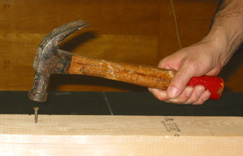More about the Law of Force and Acceleration
 A rapid change in speed (that is, a large acceleration) requires a large
force, especially if the thing that is changing its speed is massive.
We use this idea to push a nail into a piece of wood. The force required is
inconveniently large: you can't do it with your fingers. But it's easy when
you use a hammer.
Assume the nail does not move. The moving hammer will have to abruptly stop, in
a few thousands of a second. It has mass and it has speed: therefore the force that the
nail must exert on the hammer is huge. The Law of Interaction tells us that
the hammer will also exert a huge force on the nail.
A rapid change in speed (that is, a large acceleration) requires a large
force, especially if the thing that is changing its speed is massive.
We use this idea to push a nail into a piece of wood. The force required is
inconveniently large: you can't do it with your fingers. But it's easy when
you use a hammer.
Assume the nail does not move. The moving hammer will have to abruptly stop, in
a few thousands of a second. It has mass and it has speed: therefore the force that the
nail must exert on the hammer is huge. The Law of Interaction tells us that
the hammer will also exert a huge force on the nail.
Consider the statement, "It's hard to stop a speeding locomotive." This
is a reference to the Law of Motion: the locomotive is massive and it is speeding,
but we wish to stop it.
To do this at all quickly will require a very large force: it's hard.
On a curvy mountain road, the state traffic engineers place signs recommending
lower speeds at the sharper curves. It is their hope that you will not obey
the Law of Inertia, continuing in a straight line, but instead change direction
as you go around the curve. But then, according to the Law of
Force and Acceleration, the car wheels will have to exert a force in the direction of the
acceleration (towards the inside of the curve). The acceleration will be larger
when the velocity is larger, both because there is more velocity to change, and
because a faster car goes through the curve in less time.
You will find that you can't drive very fast on a bumpy road -- it doesn't
seem safe, and it certainly is uncomfortable. The Law of Force and Acceleration
can explain this:
Assume we have little bumps 1 cm high, that are 1 m apart,
and that the car is travelling at 10 m/sec. Then it only takes
1/10 second to get from one bump to another; the car will
go bumpbumpbumpbumpbump faster than you can say it.
In each 1/10 second the wheels move up and down 1 cm
(and we would, too, if we didn't have springs and shock
absorbers). So the wheels are down, and then 1/20 second
later they are 1 cm higher, and then 1/20 second later again
they are low again. The wheels move up 1 cm in 1/20
second and then down in 1/20 second. The up-and-down
speed is (about) 20 cm/second.
The speed also is changing, from up to
down in 1/20 of a second; the change is velocity is 40
cm/sec and the acceleration is 8 m/sec^2. This is a rather
large acceleration -- it is almost the acceleration of a
freely falling object, and you will indeed feel that you
are leaving your tummy behind. In reality, the springs
and shock absorbers get rid of most of this, but you
will not be able to go faster, because this decreases the time
interval and makes the vertical speed and acceleration larger.
The unit on the Law of Force and Acceleration
 A rapid change in speed (that is, a large acceleration) requires a large
force, especially if the thing that is changing its speed is massive.
We use this idea to push a nail into a piece of wood. The force required is
inconveniently large: you can't do it with your fingers. But it's easy when
you use a hammer.
Assume the nail does not move. The moving hammer will have to abruptly stop, in
a few thousands of a second. It has mass and it has speed: therefore the force that the
nail must exert on the hammer is huge. The Law of Interaction tells us that
the hammer will also exert a huge force on the nail.
A rapid change in speed (that is, a large acceleration) requires a large
force, especially if the thing that is changing its speed is massive.
We use this idea to push a nail into a piece of wood. The force required is
inconveniently large: you can't do it with your fingers. But it's easy when
you use a hammer.
Assume the nail does not move. The moving hammer will have to abruptly stop, in
a few thousands of a second. It has mass and it has speed: therefore the force that the
nail must exert on the hammer is huge. The Law of Interaction tells us that
the hammer will also exert a huge force on the nail.